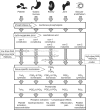The coxibs and traditional nonsteroidal anti-inflammatory drugs: a current perspective on cardiovascular risks
- PMID: 17311118
- PMCID: PMC2650648
- DOI: 10.1016/s0828-282x(07)70732-8
The coxibs and traditional nonsteroidal anti-inflammatory drugs: a current perspective on cardiovascular risks
Abstract
There is strong evidence from randomized clinical trials that the highly selective cox-2 inhibitors (coxibs), compared with placebo, cause an excess of serious cardiovascular events that are not mitigated by low-dose acetylsalicylic acid. Both Health Canada and the Food and Drug Administration have concluded that the excess cardiovascular events may be a 'class effect' of all the nonsteroidal anti-inflammatory drugs (NSAIDs), including traditional NSAIDs (tNSAIDs) and coxibs, and now require appropriate black box labelling of all these agents. Celecoxib and lumiracoxib are the only coxibs remaining on the market in Canada. The prostanoid pathways, the roles of cox-1 and cox-2, as well as the inhibitory effects of acetylsalicylic acid, traditional tNSAIDs and the coxibs, are briefly reviewed. Current recommendations for the ongoing use of coxibs and the tNSAIDs are summarized.
Un grand nombre de données provenant d’essais cliniques avec hasardisation montrent que les inhibiteurs de la cyclo-oxygénase-2 (anti-COX-2 ou « coxib »), très sélectifs, peuvent causer, par rapport au placebo, un surnombre d’événements cardiovasculaires graves, non atténués par de faibles doses d’acide acétylsalicylique. Santé Canada et la Food and Drug Administration ont conclu qu’il pouvait s’agir d’un « effet de classe » des anti-inflammatoires non stéroïdiens (AINS), y compris des AINS classiques et des anti-COX, et exigent maintenant une mise en garde entourée d’une bordure noire sur l’étiquette de tous les produits visés. Le célécoxib est le seul anti-COX à rester sur le marché au Canada. Nous ferons un survol des voies prostanoïdes et du rôle des COX-1 et -2 ainsi que des effets inhibiteurs de l’acide acétylsalicylique, des AINS classiques et des anti-COX; suivra un résumé des recommandations actuelles sur l’utilisation des anti-COX et des AINS classiques.
Figures



Similar articles
-
Nonsteroidal anti-inflammatory drugs and cardiovascular safety - translating pharmacological data into clinical readouts.Expert Opin Drug Saf. 2017 Jul;16(7):791-807. doi: 10.1080/14740338.2017.1338272. Epub 2017 Jun 8. Expert Opin Drug Saf. 2017. PMID: 28569569 Review.
-
Clinical use and pharmacological properties of selective COX-2 inhibitors.Eur J Clin Pharmacol. 2008 Mar;64(3):233-52. doi: 10.1007/s00228-007-0400-7. Epub 2007 Nov 13. Eur J Clin Pharmacol. 2008. PMID: 17999057 Review.
-
Low-dose aspirin, coxibs, and other NSAIDS: a clinical mosaic emerges.Mol Interv. 2009 Feb;9(1):31-9. doi: 10.1124/mi.9.1.8. Mol Interv. 2009. PMID: 19299662 Review.
-
COXIBs, CINODs and H₂S-releasing NSAIDs: current perspectives in the development of safer non steroidal anti-inflammatory drugs.Curr Med Chem. 2011;18(23):3494-505. doi: 10.2174/092986711796642508. Curr Med Chem. 2011. PMID: 21756233
-
Review of the cardiovascular safety of COXIBs compared to NSAIDS.Cardiovasc J Afr. 2008 Mar-Apr;19(2):102-7. Cardiovasc J Afr. 2008. PMID: 18516356 Free PMC article. Review.
Cited by
-
Resolution-promoting autacoids demonstrate promising cardioprotective effects against heart diseases.Mol Biol Rep. 2022 Jun;49(6):5179-5197. doi: 10.1007/s11033-022-07230-6. Epub 2022 Feb 10. Mol Biol Rep. 2022. PMID: 35142983 Free PMC article. Review.
-
Combination Therapy of PPARgamma Ligands and Inhibitors of Arachidonic Acid in Lung Cancer.PPAR Res. 2008;2008:750238. doi: 10.1155/2008/750238. Epub 2009 Mar 4. PPAR Res. 2008. PMID: 19277204 Free PMC article.
-
Development of Novel Pyrrole Derivatives and Their Cinnamic Hybrids as Dual COX-2/LOX Inhibitors.Molecules. 2023 Dec 5;28(24):7958. doi: 10.3390/molecules28247958. Molecules. 2023. PMID: 38138448 Free PMC article.
-
Combining anti-inflammatory and unfolding protein responses to fight stroke.Neural Regen Res. 2019 Mar;14(3):450-451. doi: 10.4103/1673-5374.245468. Neural Regen Res. 2019. PMID: 30539812 Free PMC article. No abstract available.
-
Evidence of Failed Resolution Mechanisms in Arrhythmogenic Inflammation, Fibrosis and Right Heart Disease.Biomolecules. 2022 May 19;12(5):720. doi: 10.3390/biom12050720. Biomolecules. 2022. PMID: 35625647 Free PMC article. Review.
References
-
- Bombardier C. An evidence-based evaluation of the gastrointestinal safety of coxibs. Am J Cardiol. 2002;89:3D–9D. - PubMed
-
- Waxman HA. The lessons of Vioxx – drug safety and sales. N Engl J Med. 2005;352:2576–8. - PubMed
-
- Dai C, Stafford RS, Alexander GC. National trends in cyclooxygenase-2 inhibitor use since market release: Nonselective diffusion of a selectively cost-effective innovation. Arch Intern Med. 2005;165:171–7. - PubMed
-
- Bombardier C, Laine L, Reicin A, et al. Comparison of upper gastrointestinal toxicity of rofecoxib and naproxen in patients with rheumatoid arthritis. VIGOR Study Group. N Engl J Med. 2000;343:1520–8. - PubMed
Publication types
MeSH terms
Substances
LinkOut - more resources
Full Text Sources
Other Literature Sources
Research Materials

